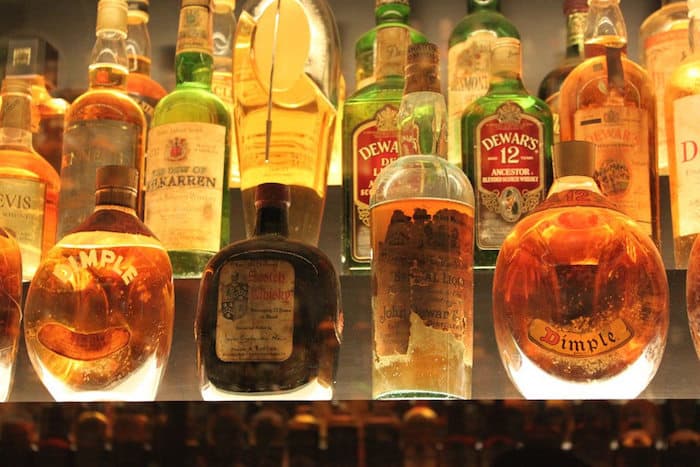There are few greater pleasures than comparing vintage whisky with its contemporary equivalent. However, the pleasure is tinged with sadness, since almost invariably the whiskies made ‘then’ are more rewarding than those made ‘now.’ In this article I want to explore why this might be so.
First, a little history. Together with ‘quality,’ ‘consistency’ has been the Scotch whisky industry’s guiding obsession for over a century. You can understand why. Until the 1880s, the flavor of whisky was wildly variable. One of the major achievements of the great blending houses which emerged from obscurity at that time was to guarantee that their products tasted the same, batch by batch, wherever in the world you bought them. Only thus could branding become possible: branding is a guarantee of consistency. Indeed, without a consistent product – of any kind – you cannot create a ‘brand.’
Like any Victorian arriviste, whisky companies soon began to invent long pedigrees for themselves and their brands. From the 1890s, Dewar’s advertised under the slogan ‘The Drink of Your Ancestors,’ in print ads to start with and later (1898) by the first film commercial ever made, commissioned from the Edison Company of New York and screened on the roof of the Pepper Building in Herald Square. After 1908, Johnnie Walker ran with the slogan ‘Born 1820. Still going strong’, a campaign which would serve them well for eighty years. The foundations for The Famous Grouse’s phenomenal emergence from obscurity in the early 1970s were laid by a campaign which proclaimed ‘Quality in an Age of Change.’ And so on.

Brand-building has been key to the success of Scotch whisky, but although batch to batch consistency of product is fundamental to any brand, there is no doubt that flavor has changed over the years. The makers of whisky, distillers and blenders, maintain there is no change: it is the same as it ever was. Connoisseurs who have the opportunity to taste old whiskies (particularly collectors) insist that today’s Scotch, both malt and blended, is quite different from that of thirty or forty years ago – let alone fifty or sixty.
Is it possible to tell? This depends upon whether whisky changes at all in the sealed bottle, stored under optimum conditions. The industry says there are no discernible changes (and therefore that the product tastes exactly the same as the day it was bottled); connoisseurs and collectors believe you start to discern subtle changes after about fifteen years, generally for the better.
Recently I was examining a bottle of Haig Pinch, a deluxe blended Scotch, with a couple of friends. It bore the Royal Warrant of ‘The Late King George V,’ so dated from between 1936 and 1938. Here are our tasting notes:
Aroma: A mild nose, but still vivacious. Good depth and richness. Some winey notes (Madeira, old brandy); fresh figs, but mainly dried fruits (dates, figs, raisins); burnt sugar becomes a key-note, and fragrant wood (mahogany shavings, sandalwood, cedarwood); a hint of scented smoke.
Flavor: Sandalwood. Light sweetness, then light tannic dryness. Fragile yet positive. Well rounded and balanced. Medium to long finish. Aftertaste of sandalwood.
This profile is quite unlike that of a contemporary bottling of Pinch – indeed it is unlike that of any contemporary Scotch – and if any of you reading this have encountered a whisky which matches the profile, let me know and I’ll rush out and buy a case!
If you were to deconstruct the notes without knowing what kind of whisky they referred to, you would be bound to conclude: a) that it had been long in the cask (the woody notes), b) that the casks had formerly contained sherry (the winey notes), c) that the blend will have contained some smoky malts (the scented smoke), d) that the whisky had been long in the bottle (the overall flavor profile).
The last conclusion assumes that you accept that changes occur in a sealed bottle. Of course, this is impossible to measure, since we cannot know what the whisky was like when the bottle was filled. Most blenders do not even refer to ‘control samples’ from their last batch, or one from last year, or the year before, since changes might have already taken place. They rely entirely on their noses and their knowledge of how the blend should smell and taste.
Robert Hicks, former Master Blender of Ballantine’s and Chivas Regal, once told me that his employer, Allied Distilleries, required any bottles which were unsold after five years to be returned by its distributors, disgorged and adjusted if required. He did admit that this had never happened: a distributor who has sat on stock for five years would not be long in the job!
Notwithstanding possible flavor changes in the bottle, one is bound to ask whether subtle changes in raw materials, process, and maturation might not have affected the flavor of vintage whisky. Barley varieties and yeast strains; centralized drum maltings, rather than individual floor maltings; the indirect firing of stills and the move from worm tubs to shell-and-tune condensers; the reduction of the human interface; the use of ex-bourbon casks rather than ex-sherry casks…it’s too big subject to explore in this article. Maybe on another occasion.
In conclusion, tasting vintage whiskies that were bottled thirty or more years ago is a rewarding past-time, especially if you compare them to current bottlings. They are surprisingly cheap at auction, or from the few companies which trade them. I have no doubt that modern whiskies are more consistent – we know much more today about the chemistry of production and maturation – but they are lighter in style and in many cases lack depth of character. I am told that these features have been incorporated to suit ‘the contemporary palate,’ but I wonder if it might also be a case of ‘flavur drift,’ a phenomenon acknowledged by blenders seeking to achieve batch-to-batch consistency over many decades.







